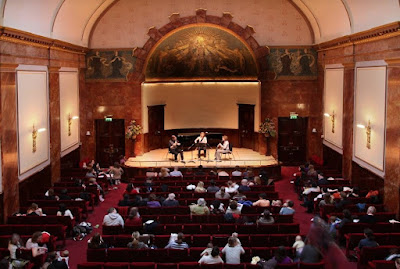I booked a number of concerts for this autumn, to hear live music again, to go to evening concerts for the first time in a decade or so, and to compare the listening experience with my hi-fi.
The first of those concerts was the Brentano Quartet at the Wigmore Hall.
The Wigmore Hall is a niche institution: amongst chamber musicians it is one of the foremost venues in the world. Superstars play there, and not at Royal Opera House prices either. The next evening, you might have a quartet of recent graduates from the Royal College of Music, even cheaper. It's a long rectangular room with a high ceiling
There are no visible signs of acoustic treatment, though the semi-circle behind the stage doubtless reflects and focuses the sound. I could not hear any reflections, and I was sitting far enough back for any reflected sounds to be heard separately.
The Brentano Quartet had the two violins sitting almost one behind the other on the left of the stage (audience's left), with the viola (front) and cello (behind) on the right. Everyone was about two metres from everyone else.
These guys play loud. I sneaked the phone out: between about 55dB-A when quiet and 80dB-A when loud. (And I was two-thirds of the way back: it must have been a good few dB louder down front.) Modern concert instruments are made to be heard at the back without amplification. Except acoustic guitars.
I listen between 55-70 db-A at home.
The soundstage is mono. Close your eyes and you can't point to the instrument as you should be able to with a hi-fi system and a decent stereo mix. I think the mono sound is intentional: a string quartet is intended to be heard as if it were one instrument. (Not to say that some pieces don't exploit a left-right effect, but it's not common.) I had to watch the players' fingers to be able to pick out the individual parts.
The soundstage of a string quartet on my stereo is pretty mono-ish, but the separation of instruments is a bit better, but that varies with the recording.
The music was arrangements for string quartet of pieces for voice by Renaissance composers - Lassus, Gesualdo, Monteverdi, Ockeghem, Wuorinen - with some pieces for strings by Richard Mico (1590-1661) in between. (I'm a sucker for a bit of Early Music, and have some Lassus, Gesualdo and Monteverdi on CD.) Transferring the voice pieces to strings brought out just how darn weird Renaissance harmony is, in comparison with Bach, Mozart and the rest of the gang. There were times it felt as if we could have been listening to a twentieth-century piece.
Definitely checking out some Richard Mico on CD or stream as well.

No comments:
Post a Comment